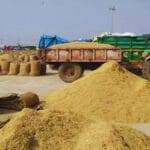Main Points In Hindi (मुख्य बातें – हिंदी में)
-
चावल कीमतों में गिरावट: भारत ने पाकिस्तान और म्यांमार से नई फसल के आयात पर सभी प्रतिबंध हटा दिए, जिसके कारण वैश्विक चावल की कीमतों में पिछले एक पखवाड़े में 10 प्रतिशत से अधिक की गिरावट आई है।
-
भारत का चावल निर्यात: भारत ने उबले हुए चावल पर सीमा शुल्क को शून्य कर दिया और सफेद चावल पर न्यूनतम निर्यात मूल्य समाप्त कर दिया, जिससे भारतीय चावल की प्रतिस्पर्धात्मकता में वृद्धि हुई है।
-
कम कंटेनर दरें: कमजोर डॉलर और शिपमेंट की कमी के कारण कंटेनर की कीमतों में गिरावट आई है, जिससे आयातकों को लाभ मिला है।
-
फिलिपींस और इंडोनेशिया का प्रभाव: फिलिपींस में व्यापारी स्टॉक करने की रुचि दिखा रहे हैं, और इंडोनेशिया का टेंडर इस दिशा में महत्वपूर्ण हो सकता है।
- भारत का चावल उत्पादन: अल नीनो के प्रभावों के बावजूद, भारत का 2023-24 के लिए चावल उत्पादन अनुमानित 137.83 मिलियन टन है, जो पिछले वर्ष से अधिक है।
Main Points In English(मुख्य बातें – अंग्रेज़ी में)
Here are 5 main points from the article:
-
Global Price Drop: Rice prices in the global market have fallen by over 10% in the last fortnight, primarily due to India lifting all restrictions on exports amidst the arrival of new crops from Pakistan and Myanmar.
-
Export Price Competitiveness: Current prices for Thai and Pakistani rice have decreased, with India’s prices dropping to levels as low as $444-448 per ton for broken rice, making it significantly more competitive against other exporters.
-
Reduced Shipping Costs: The decline in container shipping rates, due to a shortage of shipments, has also aided buyers, with prices dropping as low as $50 for container transport, further reducing overall costs.
-
Future Price Outlook: While demand for rice remains good, market analysts suggest that prices could slightly increase due to interest from Filipino traders looking to stock up, alongside the upcoming Indonesia bulog tender.
- Export Dynamics: The Indian government has previously imposed restrictions on rice exports to manage domestic food inflation and supply concerns. However, these restrictions were lifted recently, allowing a renewed flow of exports, with expectations for significant quantities to be transported from Punjab in the weeks to come.


Complete News In Hindi(पूरी खबर – हिंदी में)
व्यापारियों ने कहा कि पिछले एक पखवाड़े में वैश्विक बाजार में चावल की कीमतों में 10 प्रतिशत से अधिक की गिरावट आई है, जिसका मुख्य कारण भारत द्वारा पाकिस्तान और म्यांमार में नई फसलों के निर्यात और आगमन पर सभी प्रतिबंध हटा देना है।
“चावल कार्गो पर छूट की पेशकश की जा रही है क्योंकि मजबूत डॉलर ने स्थानीय मुद्राओं के मुकाबले मदद की है। भारत का निर्यात खुलना तब शुरू हुआ है जब पाकिस्तान और म्यांमार से नई फसल आ गई है। खरीदारों के लिए, स्थिति छिपी हुई वरदान बन गई है, ”नई दिल्ली स्थित निर्यातक राजेश पहाड़िया जैन ने कहा।
वर्तमान कीमतें
बुधवार को, थाईलैंड के 5% टूटे हुए सफेद चावल की कीमत 507 डॉलर प्रति टन बताई गई, जो 16 अक्टूबर को 529 डॉलर से कम है। वियतनाम की कीमत 537-541 डॉलर पर अपरिवर्तित है, लेकिन इसमें कटौती की उम्मीद है। पाकिस्तान की पेशकश कीमत एक पखवाड़े पहले के 481-485 डॉलर के मुकाबले 463-467 डॉलर है। इनके मुकाबले भारत में कीमतें 488-492 डॉलर की तुलना में गिरकर 444-448 डॉलर पर आ गई हैं।
25% टूटे हुए सफेद चावल की श्रेणी में, भारत $491-495 की तुलना में $434-438 प्रति टन की पेशकश कर रहा है। इसमें पाकिस्तान 424-428 डॉलर पर अधिक प्रतिस्पर्धी है, जबकि एक पखवाड़े पहले यह 440-444 डॉलर था। थाईलैंड $491 ($508) और वियतनाम 497-502 ($509-513) उद्धृत कर रहा है।
उबले हुए क्षेत्र में, थाईलैंड अपने 100% सॉर्टेक्स को $522 ($561) पर उद्धृत कर रहा है, जबकि पाकिस्तान $493-497 ($500-504) पर चावल की पेशकश कर रहा है। भारत की कीमत $439-443 ($490-494) पर सबसे अधिक प्रतिस्पर्धी है।
एग्रीकल्चरल कमोडिटीज एक्सपोर्टर्स एसोसिएशन के अध्यक्ष एम मदन प्रकाश ने कहा, “वियतनाम के लिए हमारा सफेद चावल का शिपमेंट कंटेनर में 495 डॉलर प्रति टन लागत और माल ढुलाई से घटकर 475 डॉलर प्रति टन हो गया है।”
कम कंटेनर दरें
कमजोर डॉलर के अलावा, कम कंटेनर दरों से खरीदारों को मदद मिल रही है। “शिपमेंट की कमी के कारण कंटेनर की कीमतें तेजी से गिरकर 100 डॉलर तक पहुंच गई हैं। आप $50 में भी प्राप्त कर सकते हैं,” उन्होंने कहा। हालाँकि, पिछले सप्ताह व्यापार धीमा हो गया है क्योंकि व्यापारी कीमतों में गिरावट की सीमा देखने का इंतजार कर रहे हैं।
“मांग अच्छी है। चावल बाज़ार अपना स्तर ढूँढ़ने की कोशिश कर रहा है। कीमतें थोड़ी बढ़ने की संभावना है, ”द राइस एक्सपोर्टर्स एसोसिएशन (टीआरईए) के अध्यक्ष बीवी कृष्णा राव ने कहा।
उन्होंने कहा कि कीमतें थोड़ी बढ़ सकती हैं क्योंकि फिलीपींस के व्यापारी स्टॉक करने में रुचि रखते हैं और गुरुवार का इंडोनेशिया बुलोग टेंडर इस प्रवृत्ति पर आंखें खोलने वाला हो सकता है।
जैन ने कहा कि बुलोग टेंडर के लिए 450-480 डॉलर प्रति टन की बोली लग सकती है। फिलीपींस के व्यापारी 475-480 डॉलर लागत और कंटेनरों में माल भाड़े पर चावल खरीद रहे हैं।
पंजाब से चावल ले जाना
भारत सरकार के लिए असली मुद्दा अगले कुछ हफ्तों में पंजाब से रेल रेक द्वारा 4 मिलियन टन चावल ले जाना होगा। जैन ने कहा, “भारत को धन्यवाद, वैश्विक समुदाय को सस्ता भोजन उपलब्ध होगा।”
नई दिल्ली के एक व्यापार विश्लेषक ने कहा कि मलेशिया जैसे देश पाइपलाइन में स्टॉक बनाने के लिए कम चावल का आयात करने का प्रयास कर सकते हैं। यह भी उम्मीद की जाती है कि चीन चारे और नूडल्स बनाने जैसे अन्य उद्देश्यों के लिए अच्छी मात्रा में चावल खरीदेगा।
भारत सरकार ने 23-24 अक्टूबर को चावल निर्यात पर सितंबर 2022 से लागू सभी प्रतिबंध हटा दिए। हालांकि, इसने टूटे हुए चावल के निर्यात पर प्रतिबंध बरकरार रखा। इसने उबले चावल पर सीमा शुल्क को 10 प्रतिशत से घटाकर शून्य कर दिया और सफेद चावल पर 490 डॉलर प्रति टन न्यूनतम निर्यात मूल्य (एमईपी) खत्म कर दिया।
इससे पहले 26 सितंबर को मंत्रालय ने गैर-बासमती उबले चावल, भूसी (भूरा) चावल और भूसी वाले चावल पर निर्यात शुल्क तत्काल प्रभाव से 20 प्रतिशत से घटाकर 10 प्रतिशत कर दिया था। इसके अलावा, अर्ध-मिल्ड या पूर्ण-मिल्ड चावल, चाहे पॉलिश किया हुआ हो या नहीं (उबला हुआ चावल और बासमती चावल के अलावा) को शुल्क-मुक्त करने की अनुमति है। इसने सफेद चावल पर $490 एमईपी भी तय किया।
निर्यात पर अंकुश
भारत ने सितंबर 2022 से चावल के निर्यात पर अंकुश लगाना शुरू किया जब उसने टूटे हुए चावल के शिपमेंट पर प्रतिबंध लगा दिया। इसके बाद उसने सफेद चावल पर 20 प्रतिशत निर्यात शुल्क लगा दिया। ये उपाय पूर्वी भारत के प्रमुख धान उत्पादक क्षेत्रों में खाद्य मुद्रास्फीति और कम वर्षा से निपटने के सरकार के प्रयासों के हिस्से के रूप में उठाए गए थे।
जुलाई 2023 में, देश ने सफेद चावल के निर्यात पर प्रतिबंध लगा दिया और उबले चावल पर 20 प्रतिशत निर्यात शुल्क लगा दिया। हालाँकि, सरकार ने यह स्पष्ट कर दिया है कि वह अपने पड़ोसियों सहित उन देशों के अलावा, जो खाद्य सुरक्षा के मुद्दों का सामना कर रहे हैं, सरकार-से-सरकार के आधार पर निर्यात की अनुमति देगी।
अल नीनो के उभरने के बाद आंध्र प्रदेश और कर्नाटक जैसे कुछ प्रमुख राज्यों में उत्पादन प्रभावित होने के बाद ये उपाय किए गए।
अल नीनो के देश के एक चौथाई हिस्से को प्रभावित करने के बावजूद, कृषि मंत्रालय द्वारा 2023-24 फसल वर्ष के लिए भारत का चावल उत्पादन रिकॉर्ड 137.83 मिलियन टन होने का अनुमान लगाया गया था। यह 2022-23 में उत्पादित 135.76 मिलियन टन से अधिक है।
Complete News In English(पूरी खबर – अंग्रेज़ी में)
Over the past two weeks, traders reported that global rice prices have dropped by more than 10%. This decline is mainly due to India lifting all restrictions on the export and arrival of new crops from Pakistan and Myanmar.
Rajesh Pahadia Jain, an exporter based in New Delhi, stated, “Discounts are being offered on rice cargo because a strong dollar has helped local currencies. India’s exports are opening up just as new crops from Pakistan and Myanmar are coming in, creating a hidden blessing for buyers.”
### Current Prices


On Wednesday, the price of Thai 5% broken white rice was reported at $507 per ton, down from $529 on October 16. Vietnamese prices remained stable at $537-541, but a decrease is expected. Pakistan’s offering price has fallen to $463-467 from $481-485 a week earlier. In comparison, Indian prices have dropped from $488-492 to $444-448.
For 25% broken white rice, India is offering prices between $434-438, down from $491-495. Pakistan is more competitive at $424-428, while a week ago, it was at $440-444. Thailand’s price stands at $491, and Vietnam’s is $497-502.
In the steamed rice category, Thailand quotes its 100% sortex rice at $522, while Pakistan offers rice at $493-497. India remains the most competitive with prices at $439-443.
M. Madan Prakash, president of the Agricultural Commodities Exporters Association, mentioned, “The cost of our white rice shipment to Vietnam has decreased from $495 per ton, including freight, to $475 per ton.”
### Lower Container Rates
Besides the weakening dollar, lower container shipping rates are benefiting buyers. “Container prices have dropped sharply, with some going as low as $100, and you can even find them for $50,” he noted. However, trading slowed down last week as traders awaited clarity on the extent of price drops.
“There is good demand. The rice market is trying to find its footing. Prices may rise a little,” said B.V. Krishna Rao, president of the Rice Exporters Association (TREA). He added that prices could potentially rise since Filipino traders are interested in stockpiling rice, and a tender in Indonesia on Thursday could reveal more about this trend.
Jain suggested that bids for the Indonesian tender might range from $450 to $480 per ton, with Filipino traders looking to buy rice at $475-480, including transportation costs.
### Transporting Rice from Punjab
The real challenge for the Indian government is to transport 4 million tons of rice from Punjab by rail in the coming weeks. Jain remarked, “Thanks to India, the global community will have access to affordable food.” A trade analyst in New Delhi mentioned that countries like Malaysia might try to reduce rice imports to build stockpiles. It is also anticipated that China will purchase substantial amounts of rice for making feed and noodles.
India lifted all export restrictions on rice on October 23-24 that had been in place since September 2022. However, a ban on broken rice exports remains in effect. The government also reduced customs duty on steamed rice from 10% to zero and eliminated the minimum export price (MEP) of $490 per ton on white rice.
On September 26, the ministry had already reduced the export duty on non-basmati steamed rice, brown rice, and husked rice from 20% to 10%. Additionally, it allowed duty-free export of semi-milled or fully milled rice (except steamed and basmati rice) and set an MEP of $490 for white rice.
### Export Restrictions
India initiated restrictions on rice exports in September 2022 by banning shipments of broken rice, followed by a 20% export duty on white rice. These actions were part of the government’s response to food inflation and low rainfall in key rice-producing regions of Eastern India.
In July 2023, the country imposed a ban on white rice exports and a 20% duty on steamed rice. However, the government clarified that it would permit exports on a government-to-government basis, particularly for countries facing food security issues.
Despite the impact of El Niño on a quarter of the country, the Ministry of Agriculture projected a record 137.83 million tons of rice production for the 2023-24 crop year, surpassing the 135.76 million tons produced in 2022-23.
Source link








